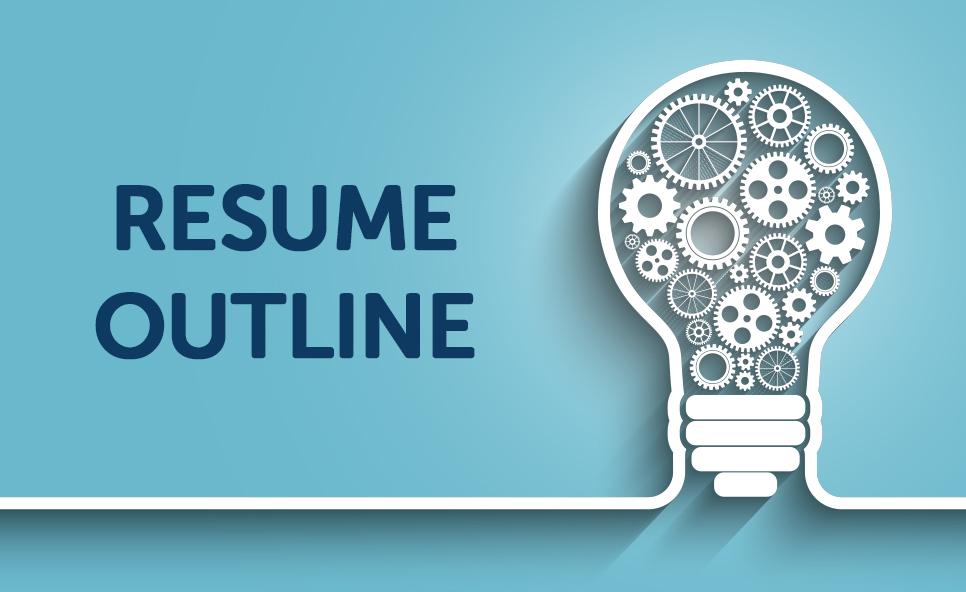



Writing a resume isn’t as easy today as it was 20 years ago. Listing your work experience and skills isn’t enough to land a great job. It takes resume writing skills as well as an understanding of how hiring managers think and what they want to see on applications. One of the basic things in developing a powerful resume is its structure. In other words, the way you arrange your resume sections will have a huge impact on how the hiring manager will approach your application. That’s why we decided to develop and share a resume outline template to help job seekers write simple yet effective resumes. Now this outline is only a general description showing the essential components and features of a resume. It should be tailored individually depending on the career goals and context; however, it can serve a good foundation for those who wish to make sure their resume will not be discarded.
Resume Outline: How to Use?
The resume outline listed below (just like any other outline) is a good starting point but it should never be an end solution to the problem. Having a resume outline is a perfect way to start writing your marketing document but before the writing stage, you should collect all of the information first. It is only when you know your target job, its requirements, as well as what relevant experience you can offer, you can actually get to writing.
So no matter what kind of resume outline you have, it is no more of a jump-off point. You shouldn’t hesitate to incorporate changes into the outline aligning them with your individual goals. It is absolutely OK to rearrange some of the sections. For example, if you are an experienced programmer, you may want to include a section with your technical skills and place it somewhere at the beginning of your resume. Or if you are still a student, your education section will more likely be appropriate right after the summary. Depending on your experience and skills, you might remove or add content as well.
The purpose of the resume outline checklist below is to help you structure your content in a way that will be appealing for hiring managers. We have developed this outline based on years of experience in career counseling and partnership with multiple recruiters and experts. As we have mentioned before, it is very generic and meant to serve only a good foundation.
Resume Outline
As you will see, there are components that are essential for every resume. That means that hiring managers tend to look for certain information on the resume. If you fail to incorporate them into your resume, it will likely result in failure. Additional (optional) components are not must-have sections but they can significantly enhance your document and position you as a stronger candidate. Consider adding additional information only when you know it will be relevant to the target job.
Contact Details
By contact details we mean the beginning of your resume. This part should include your full name, physical address, email address, and phone number. If you fail to provide any of these, the employers will likely discard your application right off the bat. It would be great if you can add a link to your LinkedIn profile. Recruiters often like checking candidates on social media before assessing them. Making their job easier will only help you along the way. Also, if you can demonstrate your previous work samples, include a portfolio link. It will not always be possible though – it all depends on the profession. If you have a personal website, don’t hesitate to mention its URL. We recommend placing your full name (bolded, slightly bigger text size or capitalized) on the very top of the page. The rest of the information should go under the name.
Summary
This is one of the most important components of a resume. Depending on how good your summary is, the prospective employer will either proceed to review your resume or will throw it to the discard pile. Some people still hesitate whether they should have an objective or summary on their resume. For us, the answer is obvious. Resume objectives are outdated and they cannot address the needs of the hiring managers. Summary, on the other hand, can help decision-makers understand where you are coming from within 10 seconds. Usually, this section shouldn’t be longer than 6 sentences and it should feature the most important information about you. In other words, this is your value proposition to the employer. If you manage to communicate your worth, then it is likely that your resume will win another 10 seconds of their attention.
Work Experience
This is the core of every resume. If you are not a student or entry-level job seeker, your work experience should be in the center of the application document. It is all about what you did and what you accomplished. This is what matters the most for those making hiring decisions. They are interested in what you did and how it matches up with the job requirements. So your task is to focus on those responsibilities and accomplishments that will communicate to the employer that you have already achieved success while doing similar stuff.
The best way to organize this section is to list all of the jobs in the reverse-chronological order. If you have an extensive employment history, focus on the last 10-15 years. Each employment should include the name of the company, its address, job title, employment dates, and the list of responsibilities/accomplishments. It would be much better if you could concentrate on what you achieved (accomplishments) rather than what you did on a daily basis (responsibilities).
Education
This is another standard section. Unfortunately, some job seekers forget about the significance of this component and as a result omit this information. First of all, education demonstrates desire to succeed. Besides, continuing education shows direction to prospective employers. Lastly, it can show if a job seeker is worth investing in. Therefore, leaving out your educational credentials is not the smartest move.
In terms of content and formatting, this section is very simple and brief. All you have to do is to list your degrees earned and the names of the educational establishments. In most cases, it is ok to have a graduation year as well.
Certifications & Licensure
If you have an extensive list of certifications to show off, it might be a good idea to create a separate section. Before doing so, make sure your certifications are relevant and they add up to your resume. Although this section doesn’t seem like a big game-changer, for some jobs certifications can be very important. For those careers where licenses and certifications are crucial, mixing certifications with other sections is not the best idea.
Follow the same format as used in the education section: certification-certifying body – date.
These components make up the core of every resume. When hiring managers don’t see at least one of the aforementioned components, there is a risk that such a resume will be ignored. Therefore, job seekers should always include these sections. However, if you’ve got more to offer that doesn’t necessarily mean that you should squeeze everything into the existing sections.
Additional Resume Outline Components
An average opening in a reputable company attracts over 200 resumes. Some of the candidates will have terrible resumes and will be discarded right away. However, it is likely that there will be those who will be very close in terms of the race for the job. That’s when additional information can make a difference! Here are some of the sections you might want to add depending on your experience and skills:
Other Skills. Many companies love people who are technically-savvy. It often comes as a preferred qualification rather than a requirement. Listing your technical proficiencies or even relevant soft skills can help you win an interview!
Memberships and Affiliations. This demonstrates your commitment to your field of interest. If you are a member of professional affiliations that relate to your target job, don’t hesitate to list them on your resume.
Publications and Presentations. Some jobs require a certain level of public speaking skills or previous research experience. If you were not able to mention these things in your work experience section, create a separate one featuring your publications and presentations.
Honors and Awards. If you have been awarded something that may help prospective employers recognize your qualifications, add it to your resume. Sometimes, these things can be incorporated into the work experience section and thus, contextualized. But when awards do not relate directly to your work experiences, you can have a separate section for this.
Community Involvement. There is nothing bad about serving people for a good cause. Many companies prefer compassionate candidates over those who have never had any exposure to charity or volunteer work.
Resume Outline Checklist
For your convenience, we have created the checklist that you can download and use to craft your own resume. All you have to do is to click on the image below and save it on your computer.








